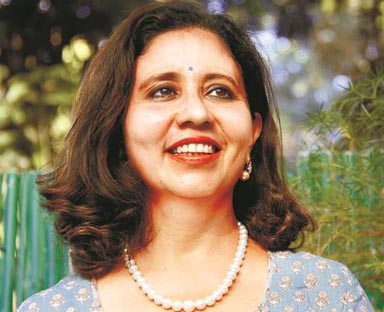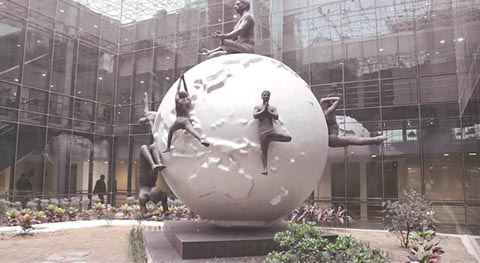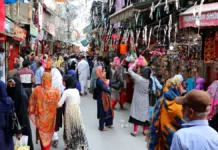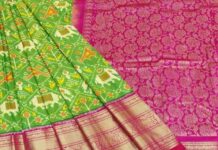The walls and corridors of the Diaspora Centre in Delhi narrate the stories of those who live abroad but find their roots in India

Masooma Rizvi could call herself a Pravasi. Her growing up years in the US made her part of the Diaspora, and her return to India after marrying an armyman, helped her traverse the length and breadth of the country and learn about various art forms. So when Rizvi — now a practicing art curator and designer — was commissioned by the office of External Affairs Minister Sushma Swaraj to decorate and turn around the Pravasi Bharatiya Kendra in Chanakyapuri — the Government of India’s showpiece for the Diaspora — her personal experience and years of observing Indian art came together.
Extensive artwork adorns the three floors of the government building, now turned into a ‘living museum’. “From the moment you enter this building to the moment you leave, you should have learnt something — that is my aim,” says 49-year-old Rizvi. The showcase starts with a multicolored peacock mural on the exterior wall. As one enters the building, one can’t miss the work dedicated to the Navagrahas (the nine planets as per the traditional Indian belief system) — a set of nine bronze works mounted on the wall; each one weighs 180 kg.
The three floors of the Pravasi Bharatiya Kendra in Chanakyapuri are replete with sculptures, paintings, wall art, digital paintings, and murals.
The huge wall opposite the Navagraha work is covered with Lipan art, which people in rural India still use to decorate the exterior of their mud houses. “This work is a message of unity in diversity. Artists from Rajasthan and Gujarat have come together to create it. So while their motifs may be different, the composite work shows how one art form is practiced at various places,” says Rizvi, who has 22 years of experience in interior design, museology, and art curation behind her.
 It was her visit to a monastery in Ladakh with her husband that made her realize the priceless art in the country. Rizvi noticed that they were “repainting the frescoes in order to preserve them”. As she moved about in the country, during her husband’s many postings, she connected with local artisans and craftsmen. She continues to use their expertise in her design projects to keep the crafts alive.
It was her visit to a monastery in Ladakh with her husband that made her realize the priceless art in the country. Rizvi noticed that they were “repainting the frescoes in order to preserve them”. As she moved about in the country, during her husband’s many postings, she connected with local artisans and craftsmen. She continues to use their expertise in her design projects to keep the crafts alive.
The centerpiece of the building is the commemorative Diaspora Gallery, which showcases the challenges the Indian Diaspora face abroad, while it also documents their achievements and contribution to the places they now call home.
The corridors are dotted with photographs of the initial set of Indian migrants, those taken from their passports. There are also photos (taken between 1917 and 1948) of the Indian Diaspora getting awards and recognitions abroad. In the centre is a two tonne boat made of bronze, with four men and a woman, symbolizing the first-ever journey Indians made to a foreign land, as indentured laborers to places like Fiji and Guyana.
An open area on the ground level is dedicated to yoga — called the Yoga Garden — with a globe in the centre, covered by figures practicing various asanas.
 Walking ahead on the ground level, towards the signature Diaspora Gallery, one encounters a “Tree of Life” created using Kalamkari art. On its branches are birds perched, symbolizing migrants. There is also an earthen pot in another corner, showcasing how democracy started in India, during the time of the Chola Empire. “The Cholas were one of the most advanced rulers, and inscriptions show they introduced the process of voting in such pots thousands of years ago,” says Rizvi.
Walking ahead on the ground level, towards the signature Diaspora Gallery, one encounters a “Tree of Life” created using Kalamkari art. On its branches are birds perched, symbolizing migrants. There is also an earthen pot in another corner, showcasing how democracy started in India, during the time of the Chola Empire. “The Cholas were one of the most advanced rulers, and inscriptions show they introduced the process of voting in such pots thousands of years ago,” says Rizvi.
All the three floors are replete with sculptures, paintings, wall art, digital paintings, and murals. The centre was inaugurated by Prime Minister Narendra Modi a few months ago. “Our challenge was to create a space wherein the Diaspora could see India’s evolution and also trace their roots. We have shown India’s journey from mythology to digital art, and we have showcased each kind of art from India, from every corner of the country,” says Rizvi.
Built in a 2.4 acre plot of land, the building is to be developed into a Centre for Diaspora Studies with an exhaustive database on the Diaspora. It has a library with a collection of more than 2,500 books on Indian culture, history, art and migration.
 The works are originals by artisans from different states. Rizvi, who was earlier called by the former President Pratibha Patil to give a presentation on Rashtrapati Bhavan decor to some visiting dignitaries, shares an interesting trivia, “Almost 40 per cent of artisans involved in the project are women.
The works are originals by artisans from different states. Rizvi, who was earlier called by the former President Pratibha Patil to give a presentation on Rashtrapati Bhavan decor to some visiting dignitaries, shares an interesting trivia, “Almost 40 per cent of artisans involved in the project are women.
These artists are also taught marketing skills. They get help in preparing their portfolio of the work done here. It’s a silent message of women empowerment as well.”
-Courtesy Indian Express






